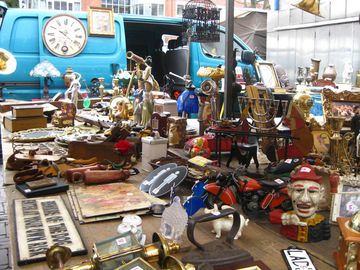

By Amsterdam standards Waterlooplein, or Waterloo Square, is not very old. Yet it is located in the middle of a neighborhood whose history dates back to the Middle Ages. The name Waterlooplein was officially adapted on the16th of December 1883, in most likelihood to honor the fighters at the battlefield where Napoleon had lost his final battle. Long before Waterlooplein came into existence this area was called Vloonburg. It lays outside the medieval walled Amsterdam on the northern shore of the Amstel. Vlooyenburg was constantly flooded by the river, hence the name Vlooyen or Flowing in English. Floods ended when in 1593 it was decided to expand the medieval city to the hitherto undeveloped piece of land. It became a neat square island, surrounded by the Amstel to the south, the Zwanenburgwal to the west, Houtgracht to the north and Leprozengracht to the east. Once upon a time Vlooyenburg, or today's Waterlooplein, was the pivot of the Amsterdam Jewish quarter. In the 17th and 18thcenturies Jewish immigrants settled around there. A lively street scene soon developed, especially since Jews couldn't own a shop - peddling was the only way. Spinoza was born in this neighborhood and a monument to him has recently been erected approximately there, where the house of his parents once stood, namely at the corner of Zwanenburgwal and the Amstel. Rembrandt stood on the border of the Jewish quarter and it was here, the legend goes, that he found the models for many of his Biblical paintings. In 1882 the street market was opened on the new city square. Shopkeepers complained that too few shoppers would venture to the new spot and that it was too windy. Contrary to their complaints, the market quickly grew in popularity. Barend de Hond recalled the prewar Waterlooplein: 'I had a friend called HartogMof, he was a rag-and-bones man and every Sunday morning we would go to the Jewish quarter. At five in the morning you could get strawberries, cherries and apples and pears on the Waterloo Square. People would take a cart and go shopping there on Sundays. Then you'd pass by the Tip Top and that's where the market started. You'd see Sally with her eggs, "four for 10 cents" she'd call out. Hard-boiled and soft eggs, all four for ten cents. As soon as you got to the edge of the market, it would start. And then there was cross-eyed Jack, he sold watches and all kinds of rubbish, but it was junk, let's be clear about it.' The Jewish vendors sold goods on the Wateroolplein up until World War II, when Nazi occupiers declared the Waterlooplein as part of the Jewish ghetto. During the 1944-45 Hunger Winter, the neighborhood's houses were looted for any valuables and even timber. Hardly any of the Jewish market shopkeepers nor residents survived the war. However in the 1960s and 70s, the market began to flourish once more largely thanks to hippies and the Flower Power movement. The entire former Vlooyenburg was condemned and demolished during construction of Amsterdam metro and the Opera House cum Town Hall, known as Stopera, was erected atop the former slum, wiping out not only a historical neighborhood, but also erasing any trace of its sinister war history. After construction works were completed, the flea market was reopened.